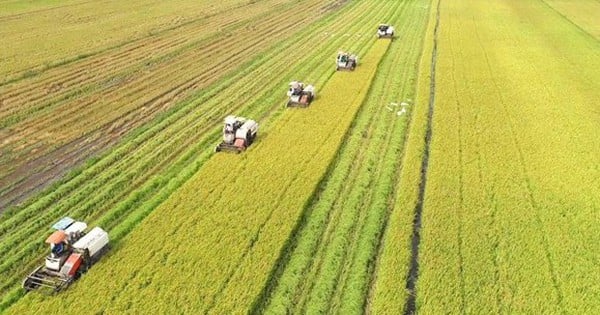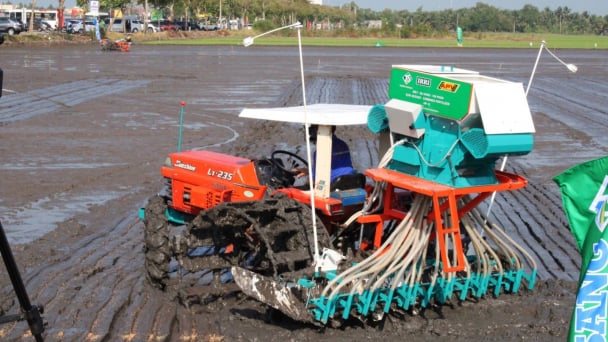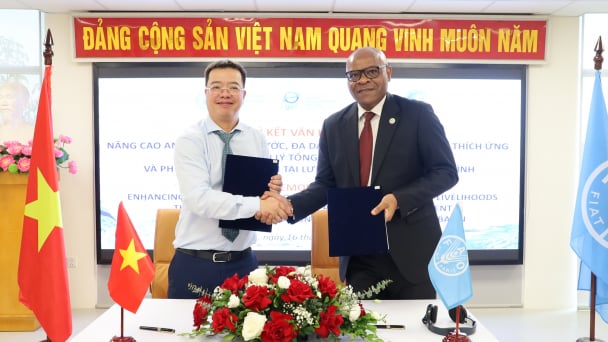May 20, 2025 | 19:47 GMT +7
May 20, 2025 | 19:47 GMT +7
Hotline: 0913.378.918
May 20, 2025 | 19:47 GMT +7
Hotline: 0913.378.918
According to the survey results on the dike and embankment system in the Mekong Delta region conducted by the Southern Institute of Water Resources Research, the entire area has a total of 8.192 dike/embankment sections, of which 6.399 are fully enclosed. In terms of flood control, there are 4.793 dike/embankment sections dedicated to this purpose. The total length of dikes and embankments is approximately 53.448km, including 18.936km of dikes/embankments used for transportation.

One of the enclosed dike sections in Hong Ngu City, Dong Thap Province. Photo: Kim Anh.
In Dong Thap province alone, there are 1.102 fully enclosed dikes and embankments, protecting nearly 190,200 hectares of production area, with a total length of over 6.700 km. Some dike sections are currently being upgraded and fortified, such as the Sa Rai dike in Tan Hong District, which is approximately 7.7km long.
Clearly, the planning, construction and development of the dike system in the Mekong Delta region and Dong Thap province in particular, have had a positive impact on rice production for local farmers.
Despite challenges such as weather conditions and pest issues from the enclosed dikes, which lead to soil degradation and prevent fields from draining floodwaters, Mr. Nguyen Dac Hoa in Hamlet 3, Sa Rai Town (Tan Hong District, Dong Thap Province) asserts that growing three rice crops/year is still more economically beneficial than in the past due to higher rice prices.
Mr. Doan Van Nam in Hamlet 3, Sa Rai Town, cultivates 12 ha of rice continuously across three crops/year. At harvest time, he only needs to oversee the process from the field's edge; once harvesting is complete, the rice is transported away for weighing and payment.
According to Mr. Nam, the yield for three-crop rice cultivation is similar to that of two crops, but cultivating three crops provides higher profits for farmers, especially about 4-5 years ago. For the summer-autumn season of 2024, his field yielded 752 kg/rod, with a profit of approximately 80 to 100 USD/rod.
A farmer from Sa Rai Town (Tan Hong District) further shared that even before the investment in the enclosed dike system in the area, local farmers had already started experimenting with cultivating rice in three crops.
When the dikes were invested in, they created pathways that not only served production purposes but also facilitated transportation for the community. With the enclosed fields, local authorities encouraged farmers to safely and securely grow rice in three crops, without incurring additional investment or maintenance costs.
This farmer also mentioned that in the past, with the enclosed dikes, cultivating rice in the third season was very productive. However, expanding the area further is not advisable. Currently, if farmers want to switch to other crops, they face high costs with uncertain returns.
In Sa Rai Town, some households have shifted to growing fruit trees or engaging in aquaculture, but these activities remain on a small scale.
“No one is giving up on the third crop of rice cultivation because everyone around is doing it. In the past, when we only grew rice in two crops, the desired yield was around 900 kg/rod (winter-spring) and 700 kg/rod (summer-autumn). Back then, we had to thresh with manual machines. After harvesting, we’d gather and dry the rice under the sun, often with no proper drying space, which was very costly. Now, with mechanical harvesting and no need for drying, the yield of rice across all three crops can be lower in years affected by natural disasters, but under normal conditions, it remains high”, the veteran farmer said.
In a discussion with Mr. Ho Van Ly, Deputy Head of the Department of Agriculture and Rural Development in Tan Hong District, we learned that the area for third-crop rice cultivation in the locality is nearly 11.000 ha/year, located within fully enclosed dike areas that provide thorough flood protection.
In practice, third-crop rice production has not been uniform, some areas have been cultivated since before 2010 - 2011. Later, as the dike system was completed, expansion began. The practice of cultivating third-crop rice in Tan Hong has been ongoing for at least 10 years.

From a high vantage point, the difference between the dike-enclosed and non-enclosed production areas in Dong Thap province is clearly visible. Photo: Kim Anh.
Mr. Ly observes that continuous cultivation of three rice crops over many years has led to nutrient depletion in the soil, increased pest and disease pressure, decreased yields. Specifically, in the past, the average rice yield in Tan Hong District was around 6.8 toto/ha/year, but now it is only about 6.3 to 6.4 toto/ha/year.
This issue had been anticipated by the local agricultural sector over a decade ago. For example, the Tan Hong District Department of Agriculture and Rural Development recommended to the district People's Committee that controlled flood release be implemented every three years within the enclosed dike areas.
The purpose of the controlled flood release is to help fields flush out chemical residues, eliminate persistent pathogens and provide sediment to the farmland.
Although this was the policy, its implementation was not successful. The reason is that during cultivation, many other agricultural activities have developed within the dike-enclosed area. Instead of solely growing rice, there are now mixed crops including vegetables, fruit trees and aquaculture. According to Mr. Ly, these agricultural activities are in conflict with each other. Consequently, before the flood season, the local authorities organized meetings to prepare for controlled flood release, but the community did not agree. This situation has persisted, and to this day, no fields within the dike-enclosed areas of Tan Hong District have been subject to controlled flood release.

While cultivating rice three times/year provides higher economic returns than before, it also increases pest pressure and higher production costs. Photo: Kim Anh.
When asked about the approach to addressing these issues, Mr. Ly stated that the local area is currently focusing on implementing the project "1 Million hectares of high-quality rice cultivation". As part of this project, the local authorities are utilizing resources to provide and support the use of organic fertilizers, helping farmers to improve and restore soil nutrients.
Additionally, they are encouraging farmers to use certified seeds, practice row sowing and sow at lower densities to reduce seed usage and limit the application of plant protection chemicals.
From the current context, according to the Southern Institute of Water Resources Research, the future development approach for the dike and embankment system in the Mekong Delta region is to encourage people to diversify their livelihoods and not to expand the area for third-crop rice cultivation.
According to Dong Thap Province's rice industry plan for 2025, the goal is to change some rice fields into high-value fruit trees and other profitable crops. This will help use land more effectively and increase farmers' incomes. Specifically, the province aims to keep rice cultivation at about 470.940 ha with a total yield of over 3 million tons. By 2025, they also plan to grow organic rice on 600 ha.
Additionally, the province will implement a crop rotation system that includes periods for controlled flood release and longer breaks between growing seasons to help restore and maintain soil fertility.
Translated by Phuong Linh

(VAN) In 2024, over 295 million people across 53 countries and territories faced acute hunger—an increase of almost 14 million people compared to 2023, while the number of people facing catastrophic levels of hunger reached a record high.

(VAN) World Environment Day 2025 (June 5) carries the theme 'Beat Plastic Pollution' continuing to emphasize the global urgency of addressing the plastic waste crisis.

(VAN) This was the assessment shared by experts at the workshop titled 'Assessing the Role and Potential of Low-Emission Rice Production Systems in Vietnam,' held on the morning of May 19.

(VAN) Cai Rong Port is the fisheries control center of Quang Ninh, helping to monitor fishing vessels, combat IUU fishing, and remove the EC's 'yellow card'.

(VAN) The German Agricultural Society (DLG) explores the possibility of establishing a mechanization service center in Vietnam’s Mekong Delta to support farmers in accessing and utilizing advanced machinery.

(VAN) On May 16, the Department of Water Resources Management, in collaboration with the Food and Agriculture Organization of the United Nations (FAO), held a signing ceremony for the GEF-8 project document.

(VAN) Food safety, mechanization, vocational training, and market opening are key areas of cooperation expected between the Vietnamese Government and the Federal Republic of Germany.